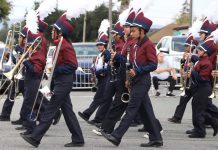San Benito High School’s scores compare favorably to statewide
results from last year’s batch of Advanced Placement testing, even
after several changes in instructors and fewer barriers to
enrollment in AP classes.
Hollister – San Benito High School’s scores compare favorably to statewide results from last year’s batch of Advanced Placement testing, even after several changes in instructors and fewer barriers to enrollment in AP classes.
“We’ve been trying some new things with the program, and I think they’re working out very well,” said SBHS Superintendent Jean Burns-Slater.
AP courses are designed to introduce high school students to college-level work. Students learn in a fast-paced, highly independent environment and take a standardized test at the end of the year. The test is graded on a scale from one to five, five being the highest, and students with a score of three or better are considered passing. Most universities will grant students college credit for the course if they pass the exam, but some institutions require a grade of four or five in order to receive credit.
The courses have become increasingly popular across the nation because they allow a student to delve deeply into subject areas of interest to them, and in the long run can save them some money – the courses are offered free, like any other high school class, and save the student from having to pay for the course in college.
Last week the College Board released Advanced Placement: Report to the Nation, which detailed how individual states performed on the exam as well as how the nation’s students performed as a whole.
In California, more than 10 percent more public school students took at least one AP exam in 2005 than the year prior, and 8.6 percent more students passed the exam than they had in 2004. Students also participated in more exams during 2005, opting to test for several subjects instead of just one.
SBHS offers 16 different AP courses, three of which – Environmental Science, Comparative Government and Music Theory – were offered for the first time last year. Of the 12 courses offered in both 2004 and 2005, half of the classes performed better than they had the year prior, while half saw their passing percentage decrease. Educators are quick to point out, however, that percentages can be a tricky thing.
“That’s the miracle of statistics,” said County Superintendent of Schools Tim Foley. “We get to compare apples and oranges on a regular basis.”
Beginning last year, SBHS allowed any interested student to take the exams, regardless of whether they had been enrolled in the class or not. As a result, the number of students tested shot up, and even though more students may have been passing then they had in a smaller class the year before, some percentages fell.
“I salute the high school for allowing students a greater opportunity to succeed and get some course credit,” Foley said. “And I’m glad that the tests are difficult – they’re not supposed to be easy.
SBHS has also lifted pre-requisites to enrolling in AP classes. Whereas before students were expected to participate in honors courses or do extremely well in regular classes or testing, students who feel prepared to tackle college-level work can take whichever courses they choose.
“A big focus of ours is student motivation,” Burns Slater said. “And if a student feels motivated enough to do well in the class, even if they haven’t shown that in their past academic performance, we don’t want to exclude them.”
Many of SBHS’ programs are performing extremely well. Economics and Calculus AB, widely regarded as two of the most grueling exams offered by the College Board, both had pass rates in the 90th percentile. And AP Physics jumped from a 42 percent pass rate to an 80 percent pass rate, even after six additional students were tested compared to the prior year. Doug Keck, who teaches AP Physics, credits the leap to an optional zero period roughly three-quarters of his class participates in once a week. Students arrive at school at 6:45am and cover material they wouldn’t normally be able to, which offers them a huge advantage.
“Physics B is a complete look at introductory physics. It’s meant to be a second-year course, but I teach it to first-year students,” Keck said. “In the past, 20 percent of the material on the test the students had covered in about 10 minutes of class time, not two days… I think it’s quite a testament to the students that they come to the optional class so regularly.”
Also taken into account is the type of exam – for Studio Art, which has boasted a 100 percent pass rate for the past three years, students submit a body of two-dimensional work culled from three years in the course. In English Language, however, students complete three essays and a multiple choice section in only a few hours, and students respond differently to different tests.
“The big thing we stress is teaching to the standards,” said Vince Parker, English Language and Composition AP teacher. “As long as we’re doing that and the kids are focused, a majority of them have the ability to pass the exam.”
The College Board reported last week that statewide, more Latino, black and socio-economically disadvantaged students are participating in the AP program than ever before. However, SBHS did not have that information available.
AP exams will be administered this year on May 10.
Danielle Smith covers education for the Free Lance. Reach her at 637-5566, ext. 336 or ds****@***********ws.com









